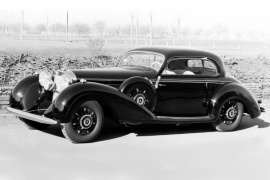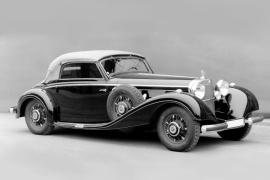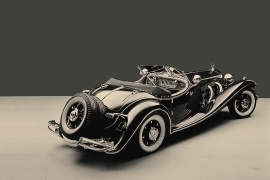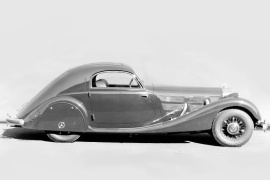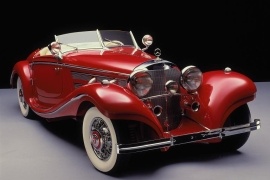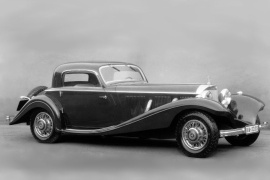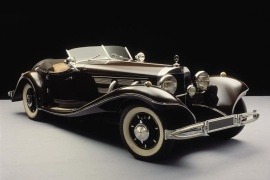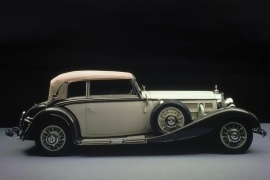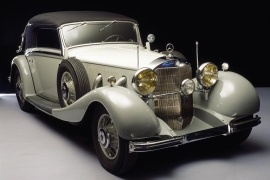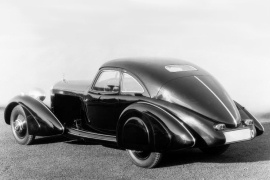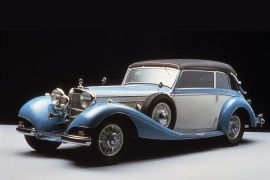MERCEDES BENZ Typ 500 K/ 540 K Models/Series Timeline, Specifications & Photos
First production year: 1934
Engines: Gasoline
Body style: Convertible (spider/spyder, cabrio/cabriolet, drop/open/soft top)
Designed as a Grand Tourer, the 540 K Spezial Coupe was the last supercharged Mercedes-Benz developed before WWII turned the world upside down.
After the Great Depression, Mercedes-Benz regained its position as a top supplier for the rich and famous. One of the lineups it created was the 500 K, which evolved later on into the 540 K thanks to the increase in the engine's displacement from 5 to 5.4-liter. The letter K designated the Kompressor (supercharger) that helped the car achieve high speeds on the recently built (at that time) Autobahn (highway), which was a network of roads with no speed limits.
The car's design followed mostly the same lines as its roadster version. At the front, the carmaker installed its already famous headlights on a curved horizontal slat mounted in front of the radiator, supported by the curved wheel fenders. Even though a bumper was not mandatory at those times, the carmaker added one welded on the chassis' endings. On the profile, unlike its open-top sibling, the Spezial Coupe featured the spare wheels mounted on the engine compartment's sides, not in the back. Thanks to the short, tilted windshield, the car offered an aerodynamic shape and a pair of long, rear-hinged doors.
Since it was a luxurious GT, the leather-wrapped interior featured a pair of bucket seats. The dash panel sported the dials in the middle.
The car's underpinnings were shared with the evolved version of the 540 K Spezial Roadster, featuring a five-speed manual gearbox with a semi-automatic feature. That meant that the driver didn't have to use the clutch pedal when shifting from fourth to fifth gear. Thanks to its hydraulic brakes, and independent suspension in all corners, the car offered a comfortable ride even at higher speeds.
Mercedes-Benz unveiled the W29 lineup in March 1934 at the International Motor and Motorcycle Show in Berlin.
The carmaker didn't specify that it will replace the model 380 with the newly introduced 500, but the complete lineup with seven bodyworks available, apart from the bare-chassis version, raise suspicions. In June 1934, Mercedes-Benz introduced the new 500 on its price list, and in the following month, it retired the Typ 380. Two years later, the carmaker increased the engine displacement from five liters to 5.4 liters leading to a new designation name, the 540. The K came from the "Kompressor," the German word for the supercharger. One of the rarest 540 K was the Cabriolet A. The carmaker offered the W29 with three open-top versions.
The Cabriolet A featured a pined-out radiator, pushed back from the bumper just behind the front axle. Its large front fenders supported the cross-beam with the big headlights and an additional set of fog lamps. On both sides, the carmaker placed the spare wheels between the rear-hinged doors and the front wheels. Mercedes-Benz built 116 units of them.
Inside, the carmaker insisted on exclusive materials. The fine leather and the wood veneers were perfectly combined with the polished metal from the steering wheel, and door handles. While other Cabriolet versions provided room for four, the Cabriolet A featured two seats at the front and a parcel at the back.
The chassis used was the long-wheelbase version, with front independent suspension and a rear swing axle with coil springs. Its 5.4-liter supercharged engine provided 180 hp when the supercharger was engaged. Mercedes-Benz paired the powerplant with a four-speed manual gearbox.
Designed as a grand tourer, the 540 K Spezial Roadster was the epitome of luxury, performance, and high-society status in mid-30s Germany.
After the Great Depression, the rich and famous expressed their desire for new, luxurious vehicles. Mercedes-Benz answered promptly in 1934 with the introduction of the W29 lineup, and especially with the 500 K, which was introduced in Berlin. Two years later, in April 1936, at the Paris Motor Show, the German carmaker unveiled an evolution over that model: the 540 K. Like its sibling, the new version showed that letter as a symbol of performance, representing the Kompressor (supercharger) installed under the hood.
Sporting the same high-performance shape of a roadster, with a long engine compartment flanked by the long, curved fenders, the 540 K impressed with its 5-meter (197") length. Unlike its siblings, the 540 K Spezial Roadster featured up to two spare wheels mounted at the back, behind the trunk lid, not on the engine compartment's sides. The V-shaped radiator and the short, tilted windshield were signs of an aerodynamically studied vehicle. Depending on the owner, the carmaker installed half-cut doors or straight ones, the latter being fitted with windows.
Mercedes-Benz installed two bucket seats inside the cockpit and a flat dashboard that sported the dials in the middle. The four-spoke steering wheel was large enough to ease the maneuvers at low speeds. As expected, the carmaker used only expensive materials such as leather, wood, and metallic, chromed trims.
In the beginning, the carmaker used the 500 K's four-speed gearboxes, but later on, it changed that to a five-speed manual transmission fitted with overdrive. Thus, the car was able to dominate the Autobahn in style, at high speeds, outperforming most of the other vehicles on the road thanks to its 5.4-liter, 180 PS (177 hp) engine.
MERCEDES BENZ Typ 540 K Spezial Roadster (W29) 540 Kompressor
In October 1936, Mercedes-Benz launched the 540K at the Paris Motor Show. It was an important upgrade over the 500 K Series, which was already on sale since 1934.
The performance-oriented customers considered the Mercedes-Benz 380 underpowered in certain circumstances and, in 1934, the German car-maker decided to introduce a newly developed chassis: the 500 K. It was offered in various bodyworks, including a bare-bone chassis to be completed by various custom body makers such as Spohn. But for the Sport-Limousine vehicles, the customers had to wait until 1936 when their wait was rewarded with the new, top-of-the-line, 540 K Sport Limousine “Spezial”.
It was more of a coupe vehicle, based on the regular chassis of the W29 model range. The inline-eight supercharged engine imposed a long hood with side exhausts. The short greenhouse was continued with the sloped rear end, in a streamlined fashion. Also, to enhance the aerodynamic, the rear wheels were covered with removable panels that could have been removed to change the wheels when needed.
Inside, there was room for two passengers. The flat seats were covered in leather, adding a touch of luxury to the expensive vehicle. The instrument panel was placed in the middle of the dashboard, with five round dials in chromed rings.
The engine was a 5.4-liter unit, which was obtained after an increase in bore and stroke of the 500 K engine. With the help of a Roots supercharger, the car was able to achieve high speeds, especially on the German highways, known as Autobahn.
MERCEDES BENZ Typ 540 K Sport-Limousine "Spezial" (W29) 540 Kompressor
The 500 K Special Roadster was one of the fastest cars from its times a customer could buy from Mercedes-Benz, and it became a cult car over the years.
In 1934, Mercedes-Benz started to replace the previous 380 model with a new generation and unveiled the 500, W29 range. By enlarging the bore and lengthening the engine's stroke, the 3.8-liter inline-eight engine grew to five liters. To further increase the power, Mercedes added a Roots supercharger with a switch on the dashboard.
The new chassis allowed the carmaker to create a long bodywork with only two seats in the cabin and two rumble seats in the back, the so-called "mother-in-law" seats by the Germans. The front of the car showed the rear-set engine position, meaning that the powerplant was installed behind the front axle. Even the pinned-out radiator sat behind the wheels hubs. The carmaker added a thick, rigid front bumper extended in front of the wheel fenders. It was a so-called "Autobahn-Kurierwagen" that described the cars built for sustained high-speed travels. A two-part, raked windshield protected the occupants from the wind. Behind the cabin, on the sloped rear end, the carmaker installed two spare wheels. One was in a special compartment covered by a lid. When both wheels were installed, that lid was removed, and the second spare came on top.
Mercedes-Benz installed rear-hinged doors to access the luxurious cabin. The leather upholstery and the wood panels were finished to perfection. A big, four-spoke steering wheel ensured the driver that it had the best possible control over the car.
Under the long hood, Mercedes-Benz installed a long engine and two additional horns. The supercharger increased the power from 100 hp to 160 hp at a touch of a button. The carmaker paired the inline-eight unit with a semi-automatic four-speed gearbox. Shifting from third to fourth didn't require the use of the clutch.
MERCEDES BENZ Typ 500 K Spezial-Roadster (W29) 500 Kompressor
The Mercedes-Benz 500K was one of the rarest vehicles built by the German car-maker. It only made 761 chassis and 70 of them were supplied to specialist coachbuilders.
On the brink of WWII, the Mercedes-Benz build the “Autobahn-Kourier”, a vehicle that offered performance, comfort, and high-class status. The car was launched in March 1934 at the International Motor and Motorcycle Show in Berlin. The new 500 model with supercharger" was exhibited in Berlin in just one version at a price that was specially constructed for particularity high speeds.
The Sport-Limousine version was one of the rarest, with only 12 various coupe variants from the total of 761 chassis built. The statistics were rounded off by 53 saloons and 28 open tourers. The car was built on the chassis with the “rear-set” engine, which means that the vehicle had the inline-eight unit behind the front axle. The big, front fenders were extended toward the cabin. The Sport-Limousine moved the spare-wheels in the back, on top of the trunk, to improve the efficiency. It wasn't about the fuel consumption, but about the aerodynamics.
The luxurious interior was matched to the high price of the vehicle. The price of the vehicle was RM 22.000, which was one of the highest prices on the market. Only the chassis cost was RM 15.000. The 500 K used a Mercedes-Benz overdrive transmission with the semi-automatic gearshift. Shifting from third (direct) gear into overdrive did not require the use of the clutch.
MERCEDES BENZ Typ 500 K Sport-Limousine (W29) 500 Kompressor
The 1935 Mercedes-Benz 500K Special Roadster was the rarest W29 vehicle built by the German car manufacturer. It was shown at the Paris Motor Show in October 1935.
It was based on a special chassis, with a rear-set engine, while the other body variants of the 500 K were built on a standard one. That meant that the big, 5-liter supercharged unit was installed further behind the front axle.
The 500 K Special Roadster was built in only 50 units, out of a total of 761 units of the 500 K with all the variants. Unlike the other open-top versions of the W29 model, the Special Roadster had only two seats. To light-up the road ahead, that version was equipped with an additional pair of lights mounted on the A-pillars.
The inline-eight engine was based on the previous 3.8-liter unit used before with an enlarged bore and stroke and a different crankshaft. It was mated to a 5-speed semi-automatic gearbox, meaning that the driver could shift from fourth to fifth gear without using the clutch. The top gear was overdrive and it was designed for the motorway high-speed use. In those times, the Autobahn (German highway) network started to take shape and, as an "Autobahn-Kurierwagen" (Highway transporter) as it was called, its performance lived up to its name.
The Special Roadster was the most expensive version of the W29 with a price-tag of RM 28.000, while the chassis-version was priced at RM 15.500 and the convertible was RM 22.000.
Mercedes-Benz introduced the W29 lineup just before the start of WWII and made it in a few versions, such as the open-top Cabriolet B.
The German automaker was already renowned for its luxurious and powerful vehicles. Even though it wasn't the most successful brand on the race tracks, its production vehicles were highly appreciated for their performance. Moreover, they were praised for their ride quality and, obviously, their luxurious amenities. They were the epitome of grand touring cars, especially in a country where there were no speed limits on the newly-developed Autobahn (highway) system.
Based on the same chassis as the Spezial-Coupe, the Cabriolet B featured was, actually, an open-top version for that. At the front, the carmaker installed its already famous headlights on a curved horizontal slat mounted in front of the radiator, supported by the curved wheel fenders. A particular feature was for the exhausts, which exited on the engine compartment's sides. Even though a bumper was not mandatory at those times, the carmaker added one welded on the chassis' endings. Thanks to the short, tilted windshield, the car offered an aerodynamic shape and a pair of long, front-hinged doors.
The leather-wrapped car interior was carefully crafted to create a luxurious environment. In addition, the wooden dash panel with its center-mounted gauges allowed the driver to constantly monitor the engine's revs, water temperature, oil pressure, and battery charging. The speedometer was the biggest dial among them, but that was not that important. At least not on the Autobahn.
The car's underpinnings were shared with the 500 K Spezial-Coupe, featuring a five-speed manual gearbox with a semi-automatic feature. Thanks to its hydraulic brakes, and independent suspension in all corners, the car offered a comfortable ride even at higher speeds.
Mercedes-Benz introduced the W29 range in 1934, and, besides the regular sedans and coupes, it also produced a few convertible versions.
After the Great Depression, the German carmaker tried to recover and introduced seven versions for the W29 lineup in June 1934, six with a bodywork provided by Mercedes-Benz and a chassis-only version. The Cabriolet C was one of them and was offered as a 2+2 open-top grand tourer built for the new Autobahn (highway) network.
Built on top of the longer wheelbase version, the Cabriolet C sported a V-shaped radiator surrounded by a chromed rim. In front of it, the carmaker installed two main headlights and a third, center-mounted headlamp on a curved slat supported by the front fenders. The bumper was mounted directly on the chassis endings, thus providing a higher level of safety for the car's occupants. In addition, Mercedes-Benz installed two spare wheels on the sides of the long engine compartment. Finally, to further enhance the aerodynamics, the windshield was tilted.
Inside, the carmaker installed a pair of bucket seats at the front and a bench for two in the back. Even though it was not very roomy, the cabin was luxurious, featuring leather upholstery and wood trims. The dashboard sported the main dials in the middle.
Under the hood, the carmaker installed a supercharged inline-eight powerplant. Its five-liter displacement provided 160 PS (158 hp), which were sent to the rear wheels via a four-speed manual transmission. The gearbox featured a semi-automatic gearshift that allowed switching from third to fourth (overdrive) without using the clutch.
The Mercedes-Benz 500K was one of the rarest vehicles built by the German car-maker.
It only made 761 chassis and only 12 were produced as coupes with a Mercedes-Benz bodywork. 70 units were sent to specialist coachbuilders.
On the brink of WWII, the Mercedes-Benz build the “Autobahn-Kourier”, a vehicle that offered performance, comfort, and high-class status. The car was launched in March 1934 at the International Motor and Motorcycle Show in Berlin. The new 500 model with supercharger" was exhibited in Berlin in just one version at a price that was specially constructed for particularity high speeds.
The car was built on the chassis with the “rear-set” engine, which means that the vehicle had the inline-eight unit behind the front axle. The big, front fenders were extended toward the cabin. The Coupe version lost the spare-wheels from the back, on top of the trunk, to improve the efficiency. It wasn't about the fuel consumption, but about the aerodynamics. That is why the rear side of the car looked like a hunchback, with a small window placed on the upper side.
The luxurious interior was matched to the high price of the vehicle. The price of the vehicle was RM 22.000, which was one of the highest prices on the market. Only the chassis cost was RM 15.000. The 500 K Coupe used a Mercedes-Benz overdrive transmission with the semi-automatic gearshift. Shifting from third (direct) gear into overdrive did not require the use of the clutch.
MERCEDES BENZ Typ 500 K "Autobahnkurier" (W29) 500 Kompressor
The German automaker introduced the Typ 540 K lineup in March 1934 at the International Motor and Motorcycle Show in Berlin in a few shapes and sizes, including a few open-top versions, such as the Cabriolet B.
In the following month, in April, the automaker revealed the prices for the new lineup and started to get orders, but only in June it unveiled the prices for the supercharged version, named 540 K. Like most other vehicles built by it, Mercedes-Benz offered the new, W29 model, in a few shapes, including a few convertibles and roadsters. Since some of its clients needed more than two seats for their vehicles, the three-pointed-star brand offered a four-door convertible named Cabriolet B.
Like its Cabriolet A sibling, the B version also featured a pined-out radiator placed behind the front axle. Its large front fenders sported the chromed cross-beam that supported the headlights. The back of the car was extended so that it could accommodate a larger cabin fitted with a rear bench. Due to that, the trunk lid was more upright than on the Cabriolet A. Finally, in the rear, the carmaker placed the taillights on top of the rear fenders, and it looked like they were added there at the last moment.
Since Mercedes-Benz was already an established luxury carmaker, the interior boasted only expensive materials. Thus, the fine leather was mixed with real wood veneers. In addition, the polished metal from the steering wheel and the dashboard created a premium ambiance. At the front, the Cabriolet B offered a pair of wide seats, while in the back, there was a bench.
The chassis used was the long-wheelbase version, with front independent suspension and a rear swing axle with coil springs. Its 5.4-liter supercharged engine provided 180 hp when the supercharger was engaged. Mercedes-Benz paired the powerplant with a four-speed manual gearbox.
